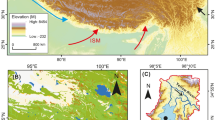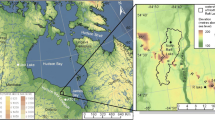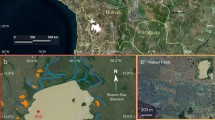Abstract
Unravelling links between climate change and vegetation response during the Quaternary is important if the climate–environment interactions of modern systems are to be fully understood. Using a sediment core from Lake McKenzie, Fraser Island, we reconstruct changes in the lake ecosystem and surrounding vegetation over the last ca. 36.9 cal kyr. Evidence is drawn from multiple sources, including pollen, micro-charcoal, biomarker and stable isotope (C and N) analyses, and is used to gain a better understanding of the nature and timing of past ecological changes that have occurred at the site. The glacial period of the record, from ca. 36.9 to 18.3 cal kyr BP, is characterised by an increased abundance of plants of the aquatic and littoral zone, indicating lower lake water levels. High abundance of biomarkers and microfossils of the colonial green alga Botryococcus occurred at this time and included large variation in individual botryococcene δ13C values. A slowing or ceasing of sediment accumulation occurred during the time period from ca. 18.3 to 14.0 cal kyr BP. By around 14.0 cal kyr BP fire activity in the area was reduced, as was abundance of littoral plants and terrestrial herbs, suggesting wetter conditions from that time. The Lake McKenzie pollen record conforms to existing records from Fraser Island by containing evidence of a period of reduced effective precipitation that commenced in the mid-Holocene.





Similar content being viewed by others
References
Appleby PG (2001) Chronostratigraphic techniques in recent sediments. In: Last WM, Smol JP (eds) Tracking environmental change using lake sediments, volume 1: basin analysis, coring and chronological techniques. Kluwer, Dordrecht, pp 171–203
Appleby PG, Oldfield F (1978) The calculation of lead-210 dates assuming a constant rate of supply of unsupported 210Pb to the sediment. Catena 5:1–8
Appleby PG, Oldfield F (1992) Application of 210Pb to sediment studies. In: Ivonavich M, Harmon RS (eds) Uranium-series disequilibrium: applications to earth, marine and environmental science. Oxford University Press, Oxford, pp 731–778
Australasian Pollen and Spore Atlas (2013) Australasian Pollen and Spore Atlas. Canberra, ACT, Australia. http://apsa.anu.edu.au/
Australian Bureau of Meteorology (2013) Australian Government. http://www.bom.gov.au/
Barr C, Tibby J, Marshall JC, McGregor GB, Moss PT, Halverson GP, Fluin J (2013) Combining monitoring, models and palaeolimnology to assess ecosystem response to environmental change at monthly to millennial timescales: the stability of Blue Lake, North Stradbroke Island, Australia. Freshw Biol 58:1614–1630
Bianchi TS, Canuel EA (2011) Chemical biomarkers in aquatic ecosystems. Princeton University Press, Princeton
Bjorck S, Wohlfarth B (2001) 14C chronostratigraphic techniques in paleolimnology. In: Last WM, Smol JP (eds) Tracking environmental change using lake sediments. Volume 1: basin analysis, coring and chronological techniques. Kluwer, Dordrecht, pp 205–245
Bohlke JK, Coplen TB (1995) Interlaboratory comparison of reference materials for nitrogen isotope ratio measurements, taken from an IAEA technical report, references and intercomparison materials for stable isotopes of light elements. IAEA-TECHDOC-825, September 1995
Bostock HC, Opdyke BN, Gagan MK, Kiss AE, Fifield LK (2006) Glacial/interglacial changes in the East Australian current. Clim Dyn 26:645–659
Bowdler S (2010) The empty coast: conditions for human occupation in southeast Australia during the late Pleistocene. In: Haberle S, Stevenson J, Prebble M (eds) Altered ecologies: fire climate and human influence. Terra Australis 32. ANU EPress, Canberra, pp 178–186
Bowling LC (1988) Optical properties, nutrients and phytoplankton of freshwater coastal dune lakes in south-east Queensland. Aust J Freshw Res 39:805–815
Bronk Ramsey C (2008) Deposition models for chronological records. Quat Sci Rev 27:42–60
Bronk Ramsey C (2009) Bayesian analysis of radiocarbon dates. Radiocarbon 51:337–360
Clark RL (1982) Point count estimation of charcoal in pollen preparations and thin sections of sediment. Pollen Spores 24:523–535
Cook EJ, Van Geel B, Van der Kaars S, van Arkel J (2011) A review of the use of non-pollen palynomorphs in palaeoecology with examples from Australia. Palynology 35:155–178
Coplen TB, Brand WA, Gehre M, Gröning M, Meijer HAJ, Toman B, Verkouteren RM (2006) After two decades a second anchor for the VPDB δ13C scale. Rapid Commun Mass Spectrom 20:3165–3166
de Mesmay R, Metzger P, Grossi V, Derenne S (2008) Mono- and dicyclic unsaturated triterpenoid hydrocarbons in sediments from Lake Masoko (Tanzania) widely extend the botryococcene family. Org Geochem 39:879–893
Donders TH, Wagner F, Visscher H (2006) Late Pleistocene and Holocene subtropical vegetation dynamics recorded in perched lake deposits on Fraser Island, Queensland, Australia. Palaeogeogr Palaeoclim Palaeoecol 241:417–439
Donders TH, Haberle SG, Hope G, Wagner F, Visscher H (2007) Pollen evidence for the transition of the Eastern Australian climate system from the post-glacial to the present-day ENSO mode. Quat Sci Rev 26:1621–1637
Eglinton TI, Eglinton G (2008) Molecular proxies for paleoclimatology. Earth Planet Sci Lett 275:1–16
Eglinton G, Hamilton RJ (1967) Leaf epicuticular waxes. Science 156:1322–1335
Gao M, Simoneit BRT, Gantar M, Jaffé R (2007) Occurrence and distribution of novel botryococcene hydrocarbons in freshwater wetlands of the Florida Everglades. Chemosphere 70:224–236
Grice K, Schouten S, Nissenbaum A, Charrach J, Sinninghe Damsté JS (1998) A remarkable paradox: sulfurised freshwater algal (Botryococcus braunii) lipids in an ancient hypersaline euxinic ecosystem. Org Geochem 28:195–216
Grice K, Audino M, Boreham CJ, Alexander R, Kagi RI (2001) Distribution and stable carbon isotopic compositions of biomarkers in torbanites from different palaeogeographical locations. Org Geochem 32:1195–1210
Grimm EC (1987) Coniss: a fortran 77 program for stratigraphically constrained cluster analysis by the method of incremental sum of squares. Comput Geosci 13:13–35
Grimm EC (1992) Tilia and Tilia-graph: pollen spreadsheet and graphics programs. In: Program and abstracts, 8th international palynological congress, Aix-en-Provence [France]
Grossi V, de Mesmay R, Bardoux G, Metzger P, Williamson D, Derenne S (2012) Contrasting variations in the structure and stable carbon isotopic composition of botryococcenes through the last glacial-interglacial transition in Lake Masoko (southern Tanzania). Org Geochem 43:150–155
Hadwen WL, Arthington AH, Mosisch TD (2003) The impact of tourism on dune lakes on Fraser Island, Australia. Lakes Reserv: Res Manag 8:15–26
Harrison S, Dodson JR (1993) Climates of Australia and New Guinea since 18,000 yrs BP. In: Wright HE Jr, Kutzbach JE, Webb T III, Ruddiman WF, Street-Perrott FA, Bartlein PJ (eds) Global climates since the last glacial maximum. University of Minnesota Press, Minnesota, pp 265–293
Hembrow S, Taffs KH (2012) Water quality changes in Lake McKenzie, Fraser Island, Australia: a palaeolimnological approach. Aust Geogr 43:291–302
Hembrow S, Taffs K, Atahan P, Parr J, Zawadzki A, Heijnis H (2014) Diatom community response to climate variability over the past 37,000 years in the sub-tropics of the Southern Hemisphere. Sci Total Environ 468–469:774–784
Hesse PP, Magee JW, van der Kaars S (2004) Late Quaternary climates of the Australian arid zone: a review. Quat Int 118–119:87–102
Hua Q, Jacobsen GE, Zoppi U, Lawson EM, Williams AA, Smith AM, McGann MJ (2001) Progress in radiocarbon target preparation at the Antares AMS centre. Radiocarbon 43:275–282
Huang Y, Street-Perrott FA, Perrott RA, Metzger P, Eglinton G (1999) Glacial-interglacial environmental changes inferred from molecular and compound-specific δ13C analyses of sediments from Sacred Lake, Mt. Kenya. Geochim Cosmochim Acta 63:1383–1404
Lees B (2006) Timing and formation of coastal dunes in northern and eastern Australia. J Coast Res 22:78–89
Longmore ME (1997) Quaternary palynological records from perched lake sediments, Fraser Island, Queensland, Australia: rainforest, forest history and climatic control. Aust J Bot 45:507–526
Longmore ME (1998) The middle Holocene ‘dry’ anomaly on the mid-eastern coast of Australia: calibration of paleowater depth as a surrogate for effective precipitation using sedimentary loss on ignition in the perched lake sediments of Fraser Island. Palaeoclimates 3:135–160
Longmore ME, Heijnis H (1999) Aridity in Australia: pleistocene records of palaeohydrological and palaeoecological change from the perched lake sediments of Fraser Island, Queensland, Australia. Quat Int 57–58:35–47
Maxwell JR, Douglas AG, Eglinton G, McCormick A (1968) The botryococcenes—hydrocarbons of nove structure from the alga Botryococcus braunii Kützing. Phytochemistry 7:2157–2171
McGowan HA, Petherick LM, Kamber BS (2008) Aeolian sedimentation and climate variability during the late Quaternary in southeast Queensland, Australia. Palaeogeogr Palaeoclim Palaeoecol 265:171–181
McNiven I (1992) Sandblow sites in the Great Sandy Region, coastal southeast Queensland: implications for models of late Holocene rainforest exploitation and settlement restructuring. Qld Archaeol Res 9:1–16
Metzger P, Largeau C, Casadevall E (1991) Lipids and mcaromolecular lipids of the hydrocarbon-rich microalga Botryococcus braunii. Prog Chem Org Nat Prod 57:1–70
Moss PT, Tibby J, Petherick L, McGowan H, Barr C (2013) Late Quaternary vegetation history of North Stradbroke Island, Queensland, eastern Australia. Quat Sci Rev 74:257–272
Neal R, Stock E (1986) Pleistocene ocupation in the south-east Queensland coastal region. Nature 323:618–621
Newcastle Pollen Collection (2002) Newcastle Pollen Collection, Newcastle, NSW, Australia. http://www.geo.arizona.edu/palynology/nsw/index.html
Petherick L, Bostock H, Cohen TJ, Fitzsimmons K, Tibby J, Fletcher MS, Moss P, Reeves J, Mooney S, Barrows T, Kemp J, Jansen J, Nanson G, Dosseto A (2013) Climatic records over the past 30 ka from temperate Australia—a synthesis from the OZ-INTIMATE workgroup. Quat Sci Rev 74:58–77
Pike KM (1956) Pollen morphology of Myrtaceae from the south-west Pacific area. Aust J Bot 4:13–53
Queensland Herbarium (2013) Regional Ecosystem Description Database (REDD). Version 6.1 (February 2013). Queensland Department of Science, Information Technology, Innovation and the Arts: Brisbane
Reeves JM, Barrows TT, Cohen TJ, Kiem AS, Bostock HC, Fitzsimmons KE, Jansen JD, Kemp J, Krause C, Petherick L, Phipps SJ (2013) Climate variability over the last 35,000 years recorded in marine and terrestrial archives in the Australian region: an OZ-INTIMATE compilation. Quat Sci Rev 74:21–34
Reimer PJ, Baillie MGL, Bard E, Bayliss A, Beck JW, Blackwell PG, Bronk Ramsey C, Buck CE, Burr GS, Edwards RL, Friedrich M, Grootes PM, Guilderson TP, Hajdas I, Heaton TJ, Hogg AG, Hughen KA, Kaiser KF, Kromer B, McCormac FG, Manning SW, Reimer RW, Richards DA, Southon JR, Talamo S, Turney CSM, van der Plicht J, Weyhenmeyer CE (2009) INTCAL09 and Marine 09 radiocarbon age calibration curves, 0-50,000 years cal BP. Radiocarbon 51:1111–1150
Rieley G, Collier RJ, Jones DM, Eglinton G, Eakin PA, Fallick AE (1991) Sources of sedimentary lipids deduced from stable carbon-isotope analyses of individual compounds. Nature 352:425–427
Ryan TS (2012) Technical descriptions of regional ecosystems of Southeast Queensland. Queensland Herbarium, Brisbane
Sachs JP, Pahnke K, Smittenberg R, Zhang Z (2007) Biomarker indicators of past climate. In: Elias S (ed) Encyclopedia of Quaternary science. Elsevier, Amsterdam, pp 19–48
Smith BN, Epstein S (1971) Two categories of 13C/12C ratios for higher plants. Plant Physiol 47:380–384
Smittenberg RH, Baas M, Schouten S, Sinninghe Damsté JS (2005) The demise of the alga Botryococcus braunii from a Norwegian fjord was due to early eutrophication. Holocene 15:133–140
Street-Perrott FA, Huang Y, Perrott RA, Eglinton G, Barker P, Khelifa LB, Harkness DD, Olago DO (1997) Impact of lower atmospheric carbon dioxide on tropical mountain ecosystems. Science 278:1422–1426
Tieszen LL (1991) Natural variations in the carbon isotope values of plants: implications for archaeology, ecology, and palaeoecology. J Archaeol Sci 18:227–248
Timms BV (1986) The coastal dune lakes of eastern Australia. In: De Deckker P, Williams WD (eds) Limnology in Australia. Springer, Nederlands, pp 421–432
Ulm S (2011) Coastal foragers on southern shores: marine resource use in northeast Australia since the late Pleistocene. In: Bicho NF, Haws JA, Davis LG (eds) Trekking the shore: changing coastlines and the antiquity of coastal settlement. Springer, New York, pp 441–461
Ulm S, Hall J (1996) Radiocarbon and cultural chronologies in southeast Queensland prehistory. Tempus 6:45–62
Vandergoes MJ, Prior CA (2003) AMS dating of pollen concentrates-a methodological study of late Quaternary sediments from south westland, New Zealand. Radiocarbon 45:479–491
Verschuren D (2003) Lake-based climate reconstruction in Africa: progress and challenges. Hydrobiologia 500:315–330
Walker WG, Davidson GR, Lange T, Wren D (2007) Accurate lacustrine and wetland sediment accumulation rates determined from 14C activity of bulk sediment fractions. Radiocarbon 49:983–992
Williams M, Cook E, van der Kaars S, Barrows T, Shulmeister J, Kershaw P (2009) Glacial and deglacial climatic patterns in Australia and surrounding regions from 35,000 to 10,000 years ago reconstructed from terrestrial and near-shore proxy data. Quat Sci Rev 28:2398–2419
Woltering M, Atahan P, Grice K, Heijnis H, Taffs K, Dodson J (2014) Glacial and Holocene terrestrial temperature variability in subtropical east Australia: branched GDGT distributions in a sediment core from Lake McKenzie. Quat Res 82:132–145
Acknowledgments
Janelle Stevenson is thanked for preparing the pollen residues. Linda Barry and Kerry Wilsher are thanked for assistance associated with sampling. Jack Goralewski and Daniela Fierro are thanked for undertaking 210Pb dating, and Fiona Bertuch and Alan Williams are thanked for assisting with AMS 14C dating. Stephen Clayton and Geoff Chidlow are thanked for technical assistance associated with GCMS and GC-IRMS measurements. Rene Diocares is thanked for assistance with EA-IRMS measurements. We thank Lorenz Schwark for helpful discussions about the research project and Yongsong Huang for generously providing a sample for compound comparison. Pierre Le Métayer and Kliti Grice were supported by an ARC Discovery grant awarded to Kliti Grice. The Australian Nuclear Science and Technology Organisation (ANSTO) and The Institute for Geoscience Research at Curtin University provided funding for this project.
Author information
Authors and Affiliations
Corresponding author
Electronic supplementary material
Below is the link to the electronic supplementary material.
Rights and permissions
About this article
Cite this article
Atahan, P., Heijnis, H., Dodson, J. et al. Pollen, biomarker and stable isotope evidence of late Quaternary environmental change at Lake McKenzie, southeast Queensland. J Paleolimnol 53, 139–156 (2015). https://doi.org/10.1007/s10933-014-9813-3
Received:
Accepted:
Published:
Issue Date:
DOI: https://doi.org/10.1007/s10933-014-9813-3




